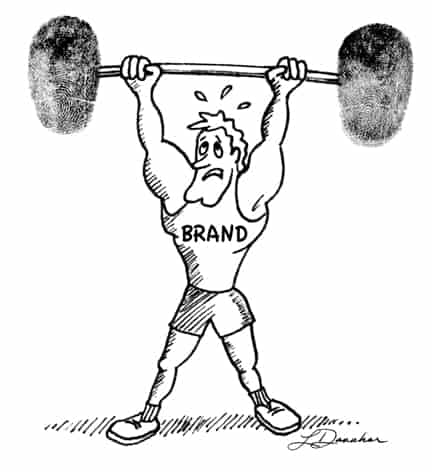“I would like a strong brand, please”
“Thank you for your request. Do you want a bag with that?”
No, it is not that easy. Lucky for us, since helping brands grow literally is our job. A strong brand is not something you can get delivered over a counter, it is something you build over time. Like building a house following a sequence of actions. But how do you do it? We can all agree that Coca Cola is a strong brand – but what makes it “strong”?
In this blog post we will provide an easy-to-read and easy-to-use summary of the Customer Based Brand Equity (CBBE) Model, a model of how you can build strong brands. We will give you a quick overview of each of the steps with a small thought experiment for each step, so you can get started working on your brand right away.
What is a strong brand?
To understand what a strong brand is, we first need to identify what a brand is. The most common definition is from The American Marketing Association (1960) stating that a brand is a name, term, symbol or any other feature that identifies one seller’s good or service as distinct from those of other sellers. Kevin Lane Keller (2001) further state that a strong brand, or the power of the brand, lies in what customer have learned, felt, seen and heard about the brand over time.
If we combine the two definitions, a brand can be viewed as a neutral entity until it hits the filter of knowledge, the customer’s brains. Then it becomes either strong or weak, the favourite brand, the forgotten brand, the first choice, the last choice. Instantly identified, instantly judged, and instantly you just lost the game.
The challenge is that we as marketers can’t control, or even know of, every single brand encounter and every piece of knowledge out there that can affect the perception of our brand. We don’t know what we are going to hit before we hit it. What we can do however, is to control what we put into the mix in the beginning and throughout our brand building efforts, by choosing the right associational triggers, and make sure that it stays consistent over time. If we start out by mapping up our brand out based on the minds of the customer, the judge, we are doing it the smart way. And that is what the Customer Based Brand Equity (CBBE) Model of Kevin Lane Keller is all about.
What is the CBBE Model?
The CBBE Model consists of four steps and six building blocks, where you establish some key elements to your brand in order to build your brand equity i.e. building a strong brand.
You can think of the four steps as the sequence of building your house, and the building blocks as the different rooms or floors. You can’t put a ceiling on top of an unbuilt house. In the same way as you can’t expect your brand to get strong without going through each of these steps.
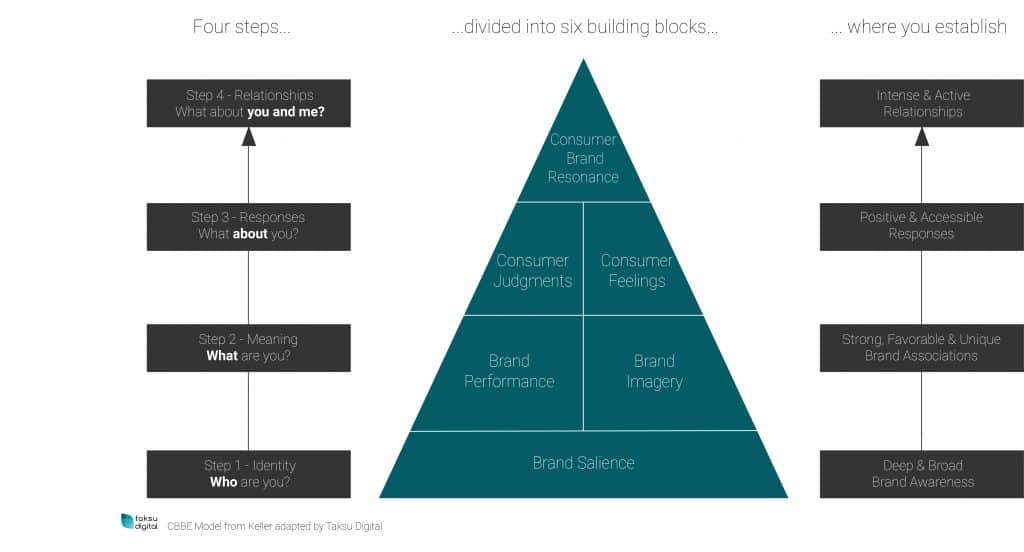
How to use the CBBE Model?
The CBBE model is a great scalable framework for both new and established brands. You can include it, or parts of it, it in your zero-point analysis to mock-up current and ideal versions of your brand, for discussions in a workshop or as a checklist for all future brand activities. If possible, it can also be an inspiration to the brand platform, or as a route map to write out your brand positioning statement.
The process follows the following four steps and we will now go through each one of them:
Step 1: Brand Identity
Step 2: Brand Meaning
Steo 3: Brand Responses
Step 4: Brand Relationships
Step 1: Brand Identity – Who are you?
The basement of your brand house is about salience and establishing brand identification so the customers know who you are.

Step 1 is about establishing salience through both depth and breadth of brand awareness. Depth refers to the probability of your brand appearing in memory, through either recall or recognition, whereas breadth refers to how many different occasions or situations your brand appears.
In other words, if you are a soda brand you want to be one of the first brands the customers think of when they are thirsty, when they are walking towards the soda shelf, when they are on the beach during summer, or when they are asked to list their top five soda brands. As an example, Fanta does strategic marketing activities that both links the brand to something fun, but always on the relevant usage situations in the category. Such as sponsoring summer beach volleyball events all over the world as you can see above. Our guess is that no one in the crowd of those events bought a Sprite during those summer days…
A task for you:
- Map out all the encounters customers may have with your category:
- Needs
- Occasions
- Situations
- Create a matrix structure with encounters as the x-axis and your marketing activities as the y-axis
- Are you nudging at the right places?
- Where are your competitors in this map?
Step 2: Brand Meaning – What are you?
The ground floor of your brand house helps to provide meaning to your brand on what you are all about, through your associations.
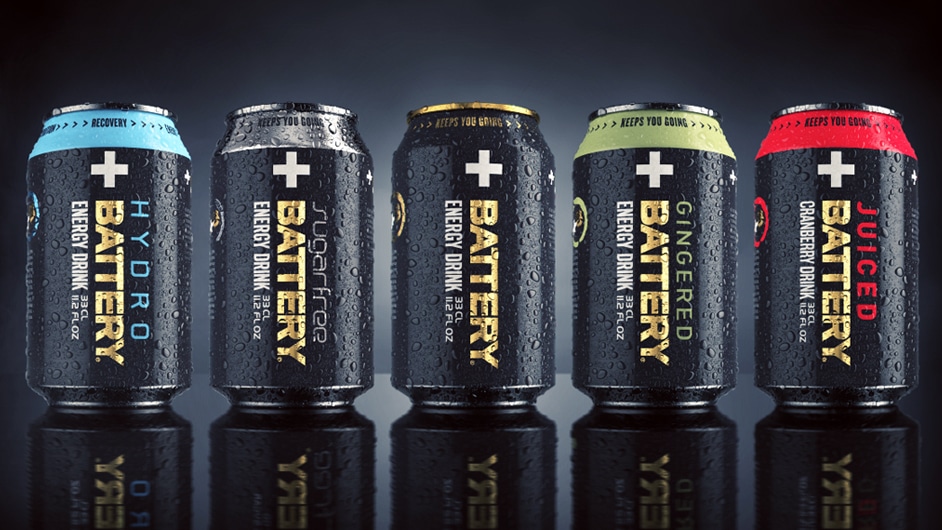
Step 2 has two building blocks. Brand Performance consists of all the tangible, functional associations if you like, such as the main characteristics: reliability, durability, serviceability, efficiency, design and price. Brand Imagery however refers to the extrinsic parts of the brand, which we often tend to forget when designing a product or service. Who typically uses this brand? Where do you buy it? What does the customer journey look like? How do you use it? What is the brand personality, values and history?
Again, if you are a soda brand, performance-associations could be your excellent grip-friendly packaging, whereas the imagery part could be customers choosing this brand because it is a healthy brand and they want to portray themselves as healthy people to their peers. Battery’s original logo and packaging as you see above is one of the strongest examples out there of strong brand performance associations. Their content marketing is also focusing a lot on the imagery part linking the product to performance areas such as studying as you can see on their Instagram profile @Batterydrink.
A task for you:
- Map up relevant Performance and Imagery associations
- Rate them on:
- Strength: Do we have a strong link between this association and our brand?
- Favourability: Is this something our customers finds important or valuable?
- Uniqueness: How distinctively is this linked to our brand vs. our competing brands?
- The ones that are both favourable and strong (or has the potential to grow) and that also are preferably, but not necessarily, unique are the associations you should base all your marketing on.
Step 3: Brand Responses – What about you?
The first floor of your brand house is about eliciting positive and accessible Brand Responses from your customers both in terms of rational judgment and emotions, so they know the totality of what it is about you that makes you special.
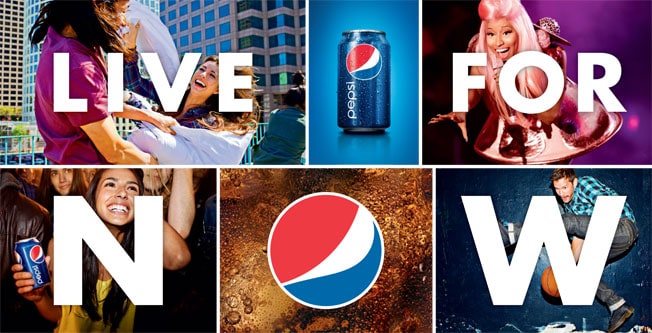
Step 3 is divided into Consumer Judgments and Consumer Feelings, referring to how customers think with their heads and feel with their heart when interacting with the brand. Consumer Judgments is basically the essence of the floors you have built up until now, but on a more personal note. If you were the customer – would the brand “do it for you”? Is it good enough, would you trust it, more than others? Consumer Feelings however, relates to the emotional response a marketing activity may evoke. Does it make the customer feel calm or stressed? Fun or sad? Excited or exhausted? Secure or scared? Do you get social approval and increased self-respect by interacting with this brand?
If we go back to the soda brand example, one typical judgment could be that the flavour is alright, nothing special and a feeling could be the brand makes make me happy. If we use Pepsi as an example, they have been all about evoking excitement, especially for the young generation, these last couple of years. But sometimes it also goes wrong and sends the brand all the way down to the basement like we saw earlier in 2017.
A task for you:
- Map out how you make the customers think and feel about your brand through the marketing initiatives you have ongoing right now.
- Ask yourself if these impressions are something you want to change.
- Look to the previous steps and see if there are specific associations you can add, make stronger or weaker with marketing initiatives to change it.
Step 4: Brand Relationships – What about you and me?
With the roof of your house we want to establish, grow and maintain intense and active Brand Relationships by making your brand resonate with your customers.
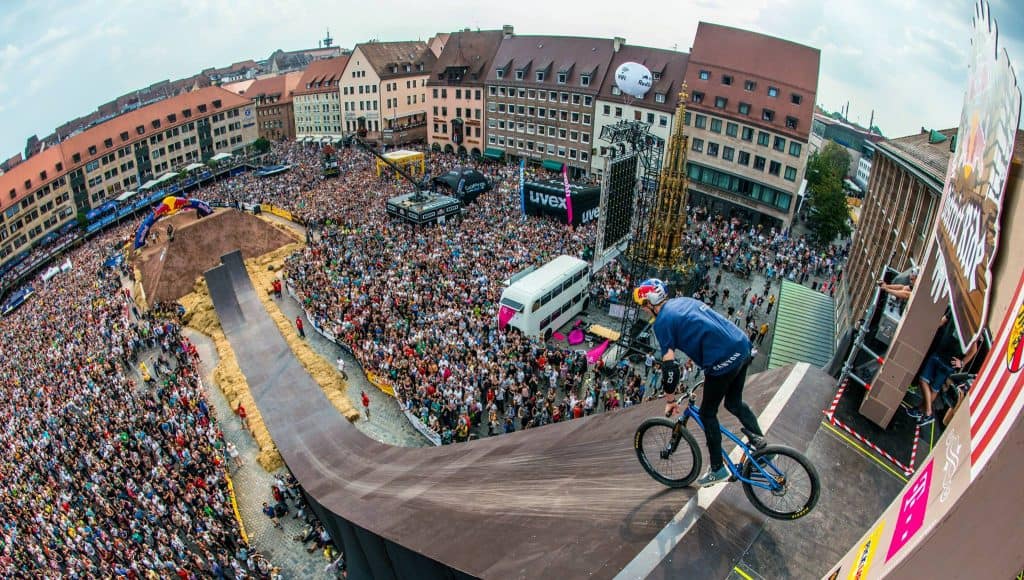
Step 4 has one building block, Brand Resonance. If done well, this can involve into intense, deep and strong psychological bonds. The key word is loyalty here, something all brand strives towards achieving. A brand relationship can be behavioural, attitudinal, through a sense of community or through active engagement, and its by definition impossible to get to this level with your customers if you haven’t succeeded with the other three steps.
For a soda brand this could translate into customers always choosing this brand, saying that they love it, the soda becoming the number one pick for all family happenings or that customers join members club or wear the brand merchandise. One example of a brand that is constantly fuelling their brand relationships is RedBull – one crazy adventurous event at a time. The image above is from one of their many crazy events.
A task for you:
- How frequently do your customers interact with your brand?
- How strong are these relationships?
- Can you grow this further?
Summary
You are now through the four steps and the six building blocks of the CBBE-model.
To sum up, what you need to do to build a strong brand is to:
Step 1: Ensure Brand Identification and get the customers to know who you are through breadth and depth of brand awareness
Step 2: Provide Brand Meaning on what you are all about, through both tangible/performing and intangible/imagery associations, that are both strong, favorable and preferably also unique.
Step 3: Elicit positive and accessible Brand Responses from your customers both in terms of rational judgments and personal emotions so they know what it is about you that makes you special.
Step 4: Establish, grow and maintain intense and active Brand Relationships by making your brand resonate with your customers.
You should always try to push your target group minds’ up these steps, all the way to the roof top. As you can see, when your brand reaches this level, you have intercepted the customer on so many levels. You have a strong brand.
But remember that it takes time, and there is always something to improve. When you have put what you think is the final roof tile, it might start to leak in the basement…
Want to become a better brand builder?
If you want to read more about this model, we recommend Keller’s very own Building Customer-based Brand Equity: A Blueprint for Creating Strong Brands (2001). Read the working paper for free here.
Recommended Branding Tools
These software tools can help you to build, optimise and nurture your brand.
-
Looka AI - Combines your design specifications with AI to design logos and create a Brand Kit by accessing 300+ branded templates to create custom marketing assets for your business.Looka AI - Combines your design specifications with AI to design logos and create a Brand Kit by accessing 300+ branded templates to create custom marketing assets for your business.
-
BrandMentions - Brand Monitoring Tool to find any page on the web where your brand or a competitor's brand has been mentionedBrandMentions - Brand Monitoring Tool to find any page on the web where your brand or a competitor's brand has been mentioned
-
4Brand Commercial - All-In-One Branding Software Helps You Easily & Quickly Create Logos, Mockups & Logo Teaser Videos4Brand Commercial - All-In-One Branding Software Helps You Easily & Quickly Create Logos, Mockups & Logo Teaser Videos
-
HotJar: Review Heatmaps of web pages and watch how users interact with your website and your brandHotJar: Review Heatmaps of web pages and watch how users interact with your website and your brand




